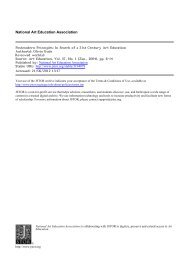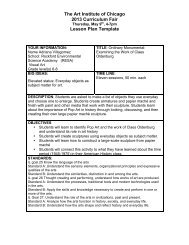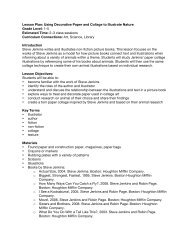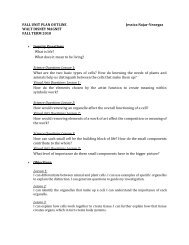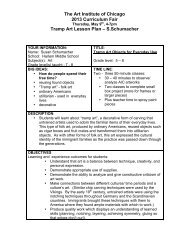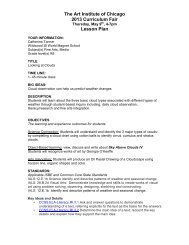Lesson 1 - LearningThroughMuseums
Lesson 1 - LearningThroughMuseums
Lesson 1 - LearningThroughMuseums
Create successful ePaper yourself
Turn your PDF publications into a flip-book with our unique Google optimized e-Paper software.
<strong>Lesson</strong> 1<br />
The Southeast: Picturing, Reading, and<br />
Writing about American Environments<br />
Summary<br />
In this lesson, students interpret a painting of a plant that requires a warm environment to grow and<br />
survive. Specifically, they learn about the magnolia, which grows in the southeastern United States.<br />
Students analyze the ways the climate of a region affects plants and learn about the representation of<br />
nature in art as they create their own drawings of the plants of a selected environment. The lesson<br />
will support student literacy skills and can be related to a focus on the science of the environment or a<br />
social studies unit on regions of the United States. You may want to specifically schedule sessions on<br />
plants and environments in order to align this lesson with your science curriculum.<br />
Featured Artwork<br />
Martin Johnson Heade (American, 1819–1904)<br />
Magnolias on Light Blue Velvet Cloth, 1885/1895<br />
Oil on canvas<br />
Illinois Benchmarks<br />
Reading<br />
1.A.2b:<br />
1.B.2a:<br />
1.C.2e:<br />
1.C.2b:<br />
Writing<br />
3.B.2a:<br />
3.C.2a:<br />
Science<br />
12.B.1a:<br />
12.B.2b:<br />
Art<br />
25.B.2:<br />
26.B.2d:<br />
Clarify word meaning using context clues and a variety of resources including<br />
glossaries, dictionaries, and thesauruses.<br />
Establish purposes for reading: survey materials; ask questions; make predictions;<br />
connect, clarify, and extend ideas<br />
Explain how authors and illustrators use text and art to express their ideas<br />
Make and support inferences and form interpretations about main themes and topics.<br />
Generate and organize ideas using a variety of planning strategies.<br />
Write for a variety of purposes and for specified audiences in a variety of forms.<br />
Describe and compare characteristics of living things in relationship to their<br />
environments.<br />
Identify physical features of plants and animals that help them live in different<br />
environments<br />
Understand how elements and principles combine within an art form to express ideas.<br />
Demonstrate knowledge and skills to create works of visual art using problem solving,<br />
observing, designing, sketching, and constructing.<br />
10 • <strong>Lesson</strong> 1: The Southeast ‒ Picturing, Reading, and Writing about American Environments



